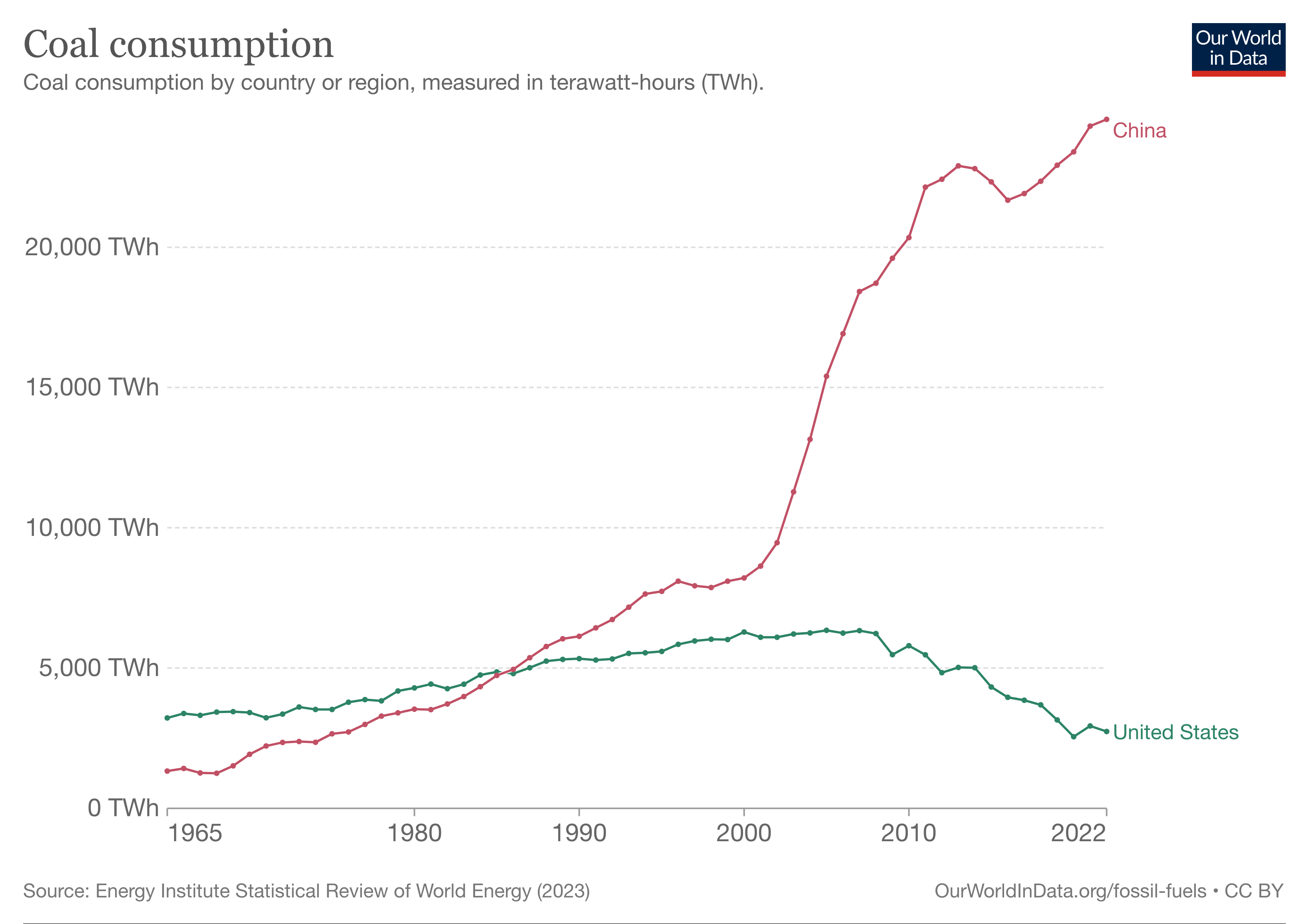President Biden’s climate envoy, John Kerry, left China empty-handed, after three days of negotiations over new ways the countries could work together to reduce carbon emissions. President Xi Jinping said China would stick to its own efforts at its own pace, and as the graph below shows, China’s pace should not be to John Kerry’s liking. Just as summer heat waves are affecting much of the Northern Hemisphere, China is burning more coal to maintain a stable electricity supply for air-conditioning. But, even before this year, China was emitting almost a third of world energy-related greenhouse gases — more than the United States, Europe and Japan combined. China burns more coal every year than the rest of the world combined. In June 2023, China generated 14 percent more electricity from coal, its dominant fuel source, than it did in June 2022.
______
Fast Facts
- President Biden’s Special Envoy on Climate, John Kerry, has failed to convince China to abandon its quest for affordable and reliable energy during his latest junket to Beijing.
- China is burning more coal than the rest of the world combined and is embarking on a coal plant construction boom.
- China is consuming nine times as much coal as the United States in pursuit of energy security and its dominance in the manufacturing of everything, including wind and solar units and other components the United States is pursuing in its climate quest.
______

Over the past two years, China had a national campaign to expand coal mines and build more coal-fired power plants, at a cost of up to $1 billion apiece. In late September 2021, hot weather overloaded China’s electric grid and caused rolling blackouts up and down the country’s seaboard that caused China to resume building coal plants. China’s workers toiled this spring to finish one of the world’s largest coal-fired power plants in southeastern China in time for this summer’s heat wave.
China sees the national campaign to increase coal usage and domestic coal mining as essential for energy security. Zhang Jianhua, director of the government’s National Energy Administration, described coal as the “ballast stone” of his country’s energy mix, saying, “Always regard the protection of national energy security as the most important mission.” Russia’s invasion of Ukraine, and the subsequent halt to Russian energy supplies to Europe, has also increased Beijing’s determination to rely on coal as the core of its energy security.
The United States, which emits far fewer greenhouse gases than China, however, is ignoring energy security by nearly halving its coal use despite having a larger domestic coal resource base than China. U.S. coal reserves are 74 percent higher than those of China. Instead, the United States is ramping up natural gas and unreliable wind and solar power that require back-up power.
While China leads the world in installing renewable energy — from solar panels to battery storage to electric cars—it recognizes the need for inexpensive and reliable coal power as its major source of electricity. As of January, China had more than 300 coal-fired power plants in various stages of proposal, permitting or construction, which is two-thirds of coal-fired capacity being developed worldwide. Practically all of China’s new plants are being built by state-owned enterprises. China is building cleaner coal plants than those in the United States because China has advanced “ultra super critical” technologies, which reduce harmful pollutants but still emit carbon dioxide. The United States has effectively made construction of new coal plants impossible.
Most of China’s biggest wind and solar projects are located in sparsely populated western and northwestern regions, where the weather is sunny and windy much of the year, far from the provinces near the coast where most of the population lives and the industrial sites are located. Factories use two-thirds of China’s electricity, and the dominant users are the steel and cement mills and glass manufacturers. Connecting the solar panel farms and wind turbines to the coastal areas requires the construction of ultrahigh-voltage power lines that are exorbitantly expensive. China’s power companies must purchase 200-meter-wide strips of land for each line over hundreds of miles. To be cost effective, the lines need to transmit electricity around the clock, but neither the sun nor the wind are available all day as they are weather-driven. China uses coal to back-up its wind and solar projects so that power can be transmitted and provided continuously.
China’s coal is mostly mined underground and mining it releases a lot of methane into the atmosphere. Methane is 20 to 80 times as potent as carbon dioxide in its warming effects in the atmosphere. Chinese physicists have estimated that a quarter of all methane emissions in China come from its more than 100,000 coal mines, mostly small mines long abandoned but still leaking gases.
Conclusion
Despite China making a pledge to peak its carbon emissions by 2030 and to reach net zero emissions by 2060, its continued growth in the usage of coal tells another story as coal plants are continuing to be built and can easily operate 4 to 5 decades. China’s carbon emissions are more than double those of the United States and as its government is focused on energy security and providing reliable energy to its population, it will continue to mine coal and produce power from coal-fired generators. The United States, as the world’s second-largest emitter of carbon emissions, behind China, has made huge strides in reducing carbon emissions with a reduction of 17 percent since 2005. While President Biden wants a reduction of 50 to 52 percent by 2030, the feasibility of reaching those numbers while keeping the grid reliable is unlikely.



